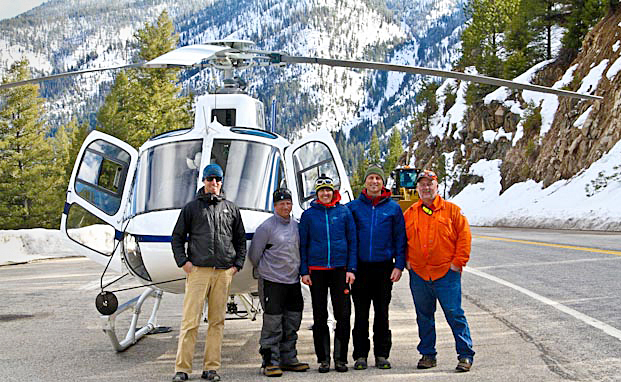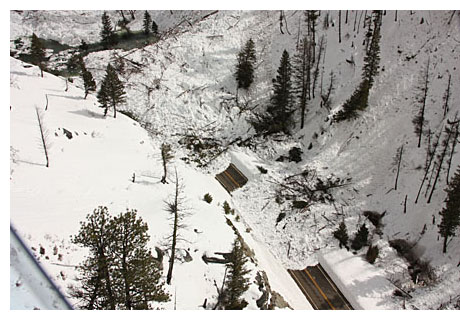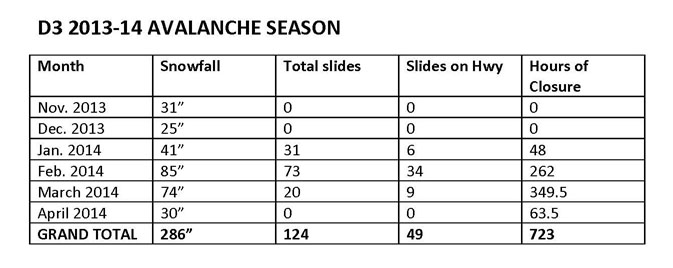

ITD's avalanche-forecast team is pictured left to right: Brian Gorsage, Brent Jenkins, Chantel Astorga and Bill Nicholson. Idaho City foreman Stuart Wilson (in orange) also is pictured.
Historic volatility: avalanche season features 124 slides in "Avalanche Alley"
 With the mercury in the 70s and 80s and temperatures climbing, it may be difficult to picture the volatility of the recent avalanche season. It's an image Bill Nicholson would just as soon forget.
With the mercury in the 70s and 80s and temperatures climbing, it may be difficult to picture the volatility of the recent avalanche season. It's an image Bill Nicholson would just as soon forget.
"It was the most challenging time in my 35-year career of dealing with avalanches," said Nicholson, ITD Southwest Idaho avalanche forecast manager.
Last year, Mother Nature took a nap during avalanche season. This year, she awoke -- in a feisty mood.
She unleashed 124 avalanches on District 3 between November 2013 and May 2014, nearly equaling the previous three years combined. Nearly 50 of those slides reached the Idaho 21 roadway in the "Avalanche Alley" section, creating havoc for drivers and residents, and for the ITD maintenance workers responsible for keeping the highway open and safe. Avalanche Alley is home to more than 60 avalanche chutes and about 90 percent of the avalanches that impact Idaho's highways each year.
The season began meekly, with little to no activity in November and December. But the introduction to 2014 was horrific. The 31 avalanches in January were just the opening act. The real headliners came in February and March.
Massive clean up
The beginning of the year was quiet. Deceptively quiet. 
"In early January we were thinking it might be the easiest season ever," said Nicholson.
Then came February and March -- 93 slides and more than 600 hours of highway closure.
"It was certainly a very challenging year, caused by an exceptionally weak snow pack and an extended spell of precipitation," explained Nicholson.
These "wet" slides proved to be a continuous problem all winter.
"A wet slide is an avalanche caused by snow losing its strength after becoming damp, moist or saturated with water," D3 avalanche forecast team member Brian Gorsage explained.
By contrast, Gorsage said, dry snow avalanches occur in snow and below-freezing temperatures.
The highway was closed in the 12-mile stretch from Grandjean Junction to Banner Summit the afternoon of March 3 for avalanche threat. The first of multiple slides occurred three days later, and the road remained closed until March 16 in the aftermath.
13 days, 20 slides
"We just kept pushing snow out of the way with the loaders and dozer, and used the excavators and dozer to sort through the snow for trees and rocks," said Idaho City maintenance foreman Stuart Wilson.
"Once we cleared out the other material, we could use the big rotary to blow out the snow."
The length of the closure, 13 days (March 3-16) made for the longest closure of the highway in at least the last six years. Until about 1986, however, this stretch of road was closed for the entire winter EVERY winter as a concession to the avalanche threat. Avalanche has been the reason for eight of the nine longest highway closures in the state since the beginning of 2008.
ITD's response to the closure cost approximately $20,000 from ITD's maintenance budget, involved more than a dozen maintenance personnel and 20 pieces of equipment.
There were 20 observed avalanches during the closure.
ITD Maintenance crews from the Idaho City and Lowman sheds, with help from Special Crew, used excavators, loaders, bulldozers and a big rotary snow plow to clear tons of snow and debris and open the route.
The dawning of spring-like temperatures offered no immediate respite, either. Of the many closures on Idaho 21 for avalanche this season, several of them came after mid-March when things started to warm.
"The first warm days are the most stressful on the snow pack," said Nicholson. "Snow, just like people, doesn't like rapid change but adjusts over time," Nicholson explained.
Historic volatility
A little farther north, a much longer section of U.S. 12 went through an unprecedented avalanche season. Even the 61-mile piece of highway from Lowell to Powell -- which hadn't closed for avalanche hazard since 2008 -- had to be closed five times.
ITD's southwest Idaho Avalanche Forecast Team -- crew leader Nicholson, and team members Gorsage, Chantel Astorga  and Brent Jenkins -- also provides slide forecasting/planning for U.S. 12.
and Brent Jenkins -- also provides slide forecasting/planning for U.S. 12.
Idaho not alone
As the February and March slides were occurring in Idaho's wilderness, Mother Nature was flexing her muscles across the region.
To the east, slide conditions buried a snowmobiling party of four in Blaine County, killing one. The western U.S. had been relatively quiet on avalanche deaths through early February, but nine people died in slides in the 10-day period ending Feb. 17, bringing the total to 15 deaths to that point in the winter season.
According to data from the National Avalanche Center in Bozeman, the six deaths prior to that had been the lowest number on record through the first week of February since at least the 1998-99 winter season. Ultimately, there were 29 fatalities due to avalanche in the 2013-14 winter season, according to the U.S. Avalanche Accidents Report at avalanche.org.
Economic Cost
Until the late 1980s, the highway was closed down all winter, every winter, so having the road open on most days is a boon, especially to the little towns, restaurants and hotels that rely on the commerce. As recently as a few years ago, closures for 60 or more days each winter season were commonplace. When the road remains closed, it impacts the public financially. The cost to the traveling public for having Idaho 21 closed is about $4,000 per day and that's not counting the cost to the economy when motorists can't get through.
"The small economies are greatly affected when the highway is closed," explained Nicholson.
Another key factor is timesavings. The closest detour is 86 miles (approximately another 120 minutes) if the road is closed. It can be almost three times that amount if motorists drive all the way to the closure gates before being forced to turn around.
Turning the tide
In just a few years, ITD's Avalanche Forecast team has been remarkably successful in reducing the number and duration of closures on Idaho¹s highways, despite a heavier snowpack than experienced in previous years.
The numbers for ITD's unit are impressive - closures have been reduced by two-thirds since the avalanche forecast team started working in 2009, despite about 65 more inches of snowfall per year than in the decade before the practice was instituted.
The 2012-13 season was only the second time in history that the road had been closed fewer than 10 days for the entire avalanche season. The 2009-10 season was the other, and the forecasters were on duty then, too.
But as the 2013-14 avalanche season showed, despite the best efforts of Nicholson and his forecast crew, ultimate control often resides elsewhere.
"This was a crazy winter; I need a nap," said Nicholson, only half kidding.
---
Photographs: (Above) Idaho 21 looked as bad from the ground as it did from the air following one slide event.

Published 6-13-14